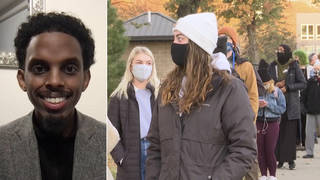
Guests
- Jennifer BrunnerOhio Secretary of State
Ohio is a key swing state that ended up deciding the outcome of the 2004 election. But the state was riddled with voting problems, ranging from breakdowns in electronic voting machines to accusations of widespread voter disenfranchisement. We speak to Democrat Jennifer Brunner, who was elected Secretary of State of Ohio in November 2006. [includes rush transcript]
Transcript
JUAN GONZALEZ: Ohio is a key swing state that ended up deciding the outcome of the 2004 election. But the state was riddled with voting problems, ranging from breakdowns in electronic voting machines to accusations of widespread voter disenfranchisement.
AMY GOODMAN: Democrat Jennifer Brunner was elected Secretary of State in Ohio in November of 2006. She replaced Republican Kenneth Blackwell. Since then, she has faced fire from virtually every side — Republicans operatives, voting machine companies, voting rights groups and more — as she has worked to resolve some of the voting problems from four years ago.
Most recently, the GOP asked a federal judge on Sunday to force Secretary of State Brunner to match voter registration information, such as a driver’s license number, against information in the state Bureau of Motor Vehicles database. Republicans filed the complaint Sunday as an extension of a previous action against a week-long period in which Ohioans could register and vote on that same day.
JUAN GONZALEZ: Ohio Secretary of State Jennifer Brunner joins us on the telephone now. Welcome to Democracy Now!
JENNIFER BRUNNER: Thank you, Juan. Good morning, Amy.
AMY GOODMAN: It’s good to have you with us. Why don’t you talk — to start off by talking about what this latest controversy is, this lawsuit?
JENNIFER BRUNNER: This is currently pending in the federal district court in the Southern District of Ohio in Columbus, and the judge will be hearing arguments on this this morning at 11:00. The Republican Party had this lawsuit in place when they were fighting the — what we call the overlap voting, which is when absentee voting started, before the close of voter registration, which allowed people to go to an early voting site, register to vote, request an absentee ballot, and vote it on the spot.
In that original lawsuit, they were denied relief, first by the federal judge, and then again by the Sixth Circuit Court of Appeals. But what they did was to try to renew a motion for a temporary restraining order and now push this effort. And what really concerns me is that the way these papers are pled, they’re looking for a list of all the mismatches by October 12th, and this is in light of the fact that at this point in time we are informed that the Social Security Administration will be shutting down its computers for the comparisons from the 10th to the 13th for maintenance over the holiday weekend. And they want that in time to — the Republican Party wants it in time to be able to file challenges twenty days before the election, to require ID, which is already required in Ohio, and also to push people into provisional voting.
JUAN GONZALEZ: Well, I’d like to ask you, you’ve been now Secretary of State — you replaced the infamous and controversial Kenneth Blackwell. And in the first year, you had a report called ”EVEREST” that looked at the situation in the voting system of Ohio. Could you tell us about some of the main concerns that you had out of that report?
JENNIFER BRUNNER: We focused on four areas. We focused on security; reliability of the equipment and the systems; the configuration, whether all of the systems throughout the state were configured to the same software level; and also whether or not procedures that local officials used were mitigating some of the concerns that we found.
Unfortunately, all of the equipment failed — I hate to say the word “miserably,” but it was a very big disappointment when we compared the equipment, which is essentially computer-based equipment, to general standards for security in the computer industry, computers that we would use for banking, for travel, for communication. The type of security that would be required was just not engineered in this equipment. Not to say that it can’t count correctly, but there were so many risks presented that we took this to the legislature, asked the legislature to fund us for all-paper ballot systems throughout the state. But unfortunately, I think in part due to budget problems in Ohio, but also due to the partisan nature of how that body is operating, they were silent on providing us with any relief.
So, what we did instead was to move forward with a bipartisan team of election officials, devise best practices for security during every step of the voting process, and then we have required security plans from every board of elections. So we’re making the best of it. In the process, we discovered that the Diebold system, as memory cards from the individual voting machines were being uploaded into the server in one county, votes were dropping. So we are in the middle of litigation against Diebold for that.
AMY GOODMAN: We’re talking to the Secretary of State of the swing state of Ohio, Jennifer Brunner. More than 666,000 new voters have been added to the voter rolls. How are you going to deal with the numbers? The famous pictures of the past, with people waiting hour after hour in the pouring rain — of course, that’s going to lead to people leaving the polling place before they vote. You’re going to — how are you dealing with close to 700,000 new voters?
JENNIFER BRUNNER: What we did was to look at what happened in Ohio in 2004. In counties like Franklin County and Columbus and where Kenyan College is, in Knox County, there was an inadequate number of voting machines to serve those voters. So we have given the boards of elections guidelines for what they need for the adequate distribution of voting machines, but — and we’ve also said to the boards, you need to actually publish to the public by the middle of October how many voting machines you will have per precinct, and if you’re not meeting the guidelines, explain why.
But we’re not leaving it there. We have fifty-three of our eighty-eight counties who use the touch-screen machines, which we understand, aside from security issues, poses a straight supply-and-demand concern. So we have backup paper ballots in the amount of 25 percent of the number of people who voted in those precincts in the last presidential election. And those boards of elections using the DREs also have to provide to us a way that voters can move in two lines, rather than one, to sign into their poll books and opt for a paper ballot if they prefer not to vote on the electronic voting machine. We think that’s going to alleviate the congestion.
And in addition, this is the first time Ohio had had absentee voting for anyone who prefers to do that without any reason at all. So we’re seeing record numbers of people voting early, and a conservative estimate is that 25 percent of Ohio’s registered voters, or the number of voters voting, will have voted before Election Day.
JUAN GONZALEZ: The New York Post today has a front-page article that touches in part on situations going on in Ohio, claiming that the group ACORN has been involved in fraudulent voter registration at apparently massive levels, according to some of their reports. What is your concern about these allegations of fraud in voter registration and people voting more than once?
JENNIFER BRUNNER: We have things built into our law so that anytime someone registers, even if they register and vote on the same day, a notification card is sent to them at their address. If that card comes back, that certainly puts that registration into question. The poll book is marked, and if that person were to show up at the polling place, Ohio law now requires that Ohioans show ID, although our ID law is much more liberal than, for instance, Indiana’s.
So — and then also our boards of elections do enter those voter registration applications into a database that automatically is sent to the Secretary of State’s database. We’re connected with T1 lines. We run that, of course, through the Bureau of Motor Vehicles, who sends it on to the Social Security Administration if it can’t get a match on driver’s license.
So, we think there are some excellent safeguards built into the law, but our own experience with ACORN in Ohio is there have been some problems in the past, but the person who we work with, when there are questions from ACORN is Katy Gall, who is a very experienced and conscientious, and we’ve had nothing but good experiences working with her.
AMY GOODMAN: Secretary of State Jennifer Brunner, what is Ohio’s laws on people who’ve served time in prison? This is confusing all over the country. Many who have come out of prison do not know that they actually can vote in most states. I mean, in places like Vermont, you can actually vote from prison. But what are Ohio’s laws here?
JENNIFER BRUNNER: In Ohio, it’s very simple. If a person has been convicted of a felony, as long as they are not incarcerated on that felony, they can register and vote. Now, for instance, if they’re convicted of, say, possession of cocaine, a fifth-degree felony, and they’re placed on probation, they can certainly be registered and vote. If, for instance, they violate their probation and they’re incarcerated on that probation violation, they would not be able to vote during that period of time. But that is — and interestingly enough, if someone is in jail on a misdemeanor, they can vote from jail, or if they’re in jail awaiting trial on new charges and not convicted of something, they can vote from jail.
JUAN GONZALEZ: One of the things that all of us remember from the 2004 elections were these long lines in some polling places in Ohio versus no lines in others. Now, we understand that each county basically controls its own election apparatus, but what have you been able to do to assure an equitable distribution of voting machines so that every person in Ohio has basically the same access to exercise their right to vote?
JENNIFER BRUNNER: Well, for the first time, we’ve issued a directive that tells the boards of elections, here are the factors that you need to consider when allocating your voting machines, things like past turnout, new registrations, any recent purges under the NVRA, the National Voter Registration Act, in addition to how many ballot issues you have on the ballot, because it takes longer for people to vote ballot issues. And we’ve said you’ve got to have a minimum of one machine per 175 voters, when we’re talking about the touch-screen machines, and if you are not meeting those guidelines, you have to explain to us why. But then, as we said before, the safety net there is the backup paper ballots, which can be used if machines malfunction, if a voter simply prefers a backup paper ballot, or if the lines get to be too long.
AMY GOODMAN: It is highly unusual, what happened in Ohio. You can register and vote on the same day. When was that period? When did it just end? How many people voted? And again, the numbers you have now, quite amazing, after registration just finished on Monday: 8,184,138, the highest number of registered voters ever in the state. What happened? And do you see this as a model, of registering and voting on the same day, something Republicans fought?
JENNIFER BRUNNER: The period of registration where you could still — where you could register and vote on the same day began on September 30th, and it ended Monday, October the 6th. We requested information from all the counties on those voting figures, which we should be getting back today.
I can tell you, for instance, in Cuyahoga County, just the number of people who showed up to vote early, whether or not they registered in that week period of time, was 8,000. In one day, the Cuyahoga County Board of Elections handled 2,500 voters at the Board of Elections. I was at the board yesterday in Cuyahoga. It’s an amazing operation. They have about, I believe, forty-five stations, where people can check in, have their registration checked, get a ballot, and it’s — they have two different floors people can vote on and 400 parking places. It’s a fantastic operation.
Second part of your question, Amy, I’m sorry, I lost that one.
AMY GOODMAN: The second part is, nationally, being a model, the idea of voting and registering on the same day?
JENNIFER BRUNNER: This is not something new. States like Minnesota and North Dakota already do — and I believe Montana — already do this for all of their voters. And interestingly enough, in Minnesota, there’s no need for a provisional ballot.
The fears that were being expressed and pushed to the national media by the Ohio Republican Party really are unfounded. When you look at what happened in a period — a four-year period in Ohio, in terms of actual voter fraud, we had four individual cases with nearly eight million registered voters in a four-year period, and one was a husband and wife. As I said before, we’ve got the notices that go out when a person registers.
So, I think, you see, what’s happened here is that the Republican Party wants to push out that somehow the Secretary of State made this up. Unfortunately for them, the Republicans have held the Ohio Senate for twenty-four years and the Ohio House for fourteen years. And apparently, when they adopted in 2005 this no-fault absentee voting, they just didn’t figure out what the consequences were.
I look for, in the lame-duck session, the Republicans, who will still be in control, to move to eliminate this five-day window. But, you see, if you look at Ohio law — and there is such thing as a provisional ballot for absentee voting —- Ohio law does not kick that provisional voting in for absentee until the twenty-eighth day before the election. And when you think about this five— to seven-day period, you have the voter there, the voter is registered, the voter has provided ID, and the voter has their ballot. You have everything that you need from this voter. Now, if it would be someone who’s going to take a risk to their liberty and commit a felony, we’re probably going to find out about it, because when we send that notice to them and they don’t respond and it comes back and they don’t live where they say they live, prosecutors are going to go after them.
AMY GOODMAN: Well, Jennifer Brunner, we want to thank you very much for being with us, Ohio Secretary of State. We’re going to continue our voting special after break with a new study by the Brennan Center for Justice on voters across the country, voting being purged through a process that’s shrouded in secrecy.












Media Options